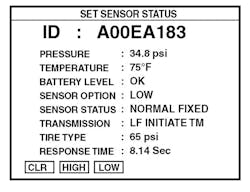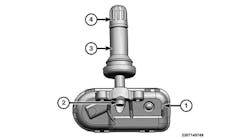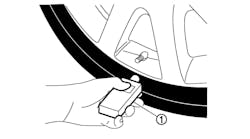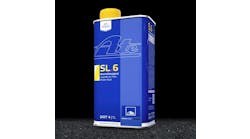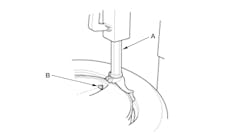SUBJECT VEHICLE: Hyundai Sonata 2008-2010
RELEARN PROCEDURE? Yes.
SPECIAL TOOLS NEEDED? Yes, a TPMS exciter scan tool.
The tire pressure monitoring system (TPMS) of the 2008-2010 Hyundai Sonata monitors the air pressure in the four road tires with wheel-mounted tire pressure sensors. To do this, the system uses a receiver, four radio frequency (RF) tire pressure sensors, a warning indicator on the instrument cluster, and a data circuit to perform system functions.
When tire pressure is below the allowed threshold, the low pressure warning light on the instrument cluster will be illuminated. The receiver has an auto-learn function that takes place once per ignition cycle. Upon successful completion, the four tire pressure sensor IDs are latched into memory for monitoring. Until the auto-learn function is completed, the previously learned sensors are monitored. The receiver uses vehicle speeds of 12 mph (20 KM/H) or more for up to 20 minutes to learn a new sensor.
TPMS warning light
NOTE: Tire pressure is also dependent on temperature of the tire. Tire pressure should only be adjusted when tires are cold (about the same as ambient air temperature). When the low tire pressure warning light comes on, check the air pressure of all tires and adjust to specification. If the tire is damaged, repair as necessary. Ensure the warning light goes off. If the warning light is still on, there is a malfunction in the TPMS. See appropriate manufacturer service information.
Reset procedures
NOTE: If the tire pressure sensor is replaced, it will need to be initiated. The TPMS is not affected by wheel and tire rotation. When the low tire pressure warning light comes on, check the air pressure of all tires and adjust to specification. Ensure the warning light goes off.
Tire pressure sensor initiation
NOTE: In the following procedure, a TPMS exciter scan tool must be used.
NOTE: When four sensors have been learned as road wheels, it is not possible to learn new road wheel sensors on the same ignition cycle.
NOTE: Do not perform this procedure if the vehicle is parked on a metal floor, roof or on an alignment rack or lift. The metal will transfer the RF signals, which can cause the learn procedure to fail and set diagnostic trouble codes (DTCs).
NOTE: The sensor’s default state will be Storage Auto (High Line).
1) Using TPMS exciter, change the sensor mode to Normal Fixed Base (Low Line). See Figure 1.
NOTE: Sensors which were already configured as Base (Low Line) will take longer to read.
2) Holding the TPMS exciter within three inches (76 mm) of the sensor valve, read each tire pressure sensor ID in the following order: front left, front right, rear left, then rear right.
3) Connect the TPMS exciter to Data Link Connector (DLC) located under left side of instrument panel. Register the four sensor IDs to the receiver (see Figure 2 and Figure 3).
NOTE: The TPMS receiver will complete the learn procedure of the new sensor after the vehicle is driven up to 20 minutes at speeds over 12 mph (20 KM/H).
4) Cycle Ignition, wait four minutes and check that “NORMAL RECEIVER STATE” is now displayed.
Demounting/mounting procedures
CAUTION: The tire should be demounted from the wheel using the tire changer manufacturer’s instructions. Use the following information to avoid damage during the demounting/mounting procedures.
CAUTION: Ensure that the wheel to be fitted is designed for the sensor mount. There should normally be a mark to indicate this. Tire pressure sensors can be used on steel or aluminum rims.
NOTE: If the tire pressure sensor is replaced, it will need to be initiated. See reset procedures. The TPMS is not affected by wheel and tire rotation.
Tire pressure sensor
CAUTION: Do not use puncture repair fluid, as this can cause the sensor pressure port to block and an incorrect warning to occur.
Removal
1) Remove the wheel and tire assembly. CAUTION: Avoid tire/tool contact with the valve while demounting the tire.
2) Deflate the tire and remove balance weights. The tire bead should be broken about 180 degrees from the valve side of the wheel. The bead breaker should not be set too deep. Demount should end near the valve. CAUTION: The valve nut should not be re-used.
3) While handling the sensor with care, remove the valve nut.
4) Discard the valve assembly.
Installation
CAUTION: Avoid bringing the tire pressure sensor in contact with any lubricant. Always handle the tire pressure sensor carefully.
1) Assemble the valve to the sensor, and turn the valve three times with the square part of the screw in the slot (see Figure 4). CAUTION: Ensure the sensor feet are against the wheel throughout the remainder of the assembly process.
2) Ensure that the valve hole and mating face of the wheel are clean. Mount the assembly to the wheel. The fit should not be tight (i.e., it should still be possible to easily adjust the valve angle). CAUTION: Ensure the grommet remains in contact with the wheel.
3) Tighten the washer and nut by hand until the valve thread meets the nut built-in calibrated stop (see Figure 5). CAUTION: While tightening the nut, do not exceed allowed torque. Do not use electric or pneumatic tools.
4) Using a torque wrench, tighten the nut to 31 – 40 in.-lbs. (3.5-4.5 N.m). It is normal to feel a break as the 20 in.-lbs. (2.3 N.m) calibrated stop in the nut snaps and the torque falls. Increase torque smoothly in order to achieve a clean break of the stop.
5) Lubricate the tire bead (not the rim). Do not use excessive lubrication.
6) Start tire mounting about 5.9 inches (15 cm) from the valve. Move the mounting tool away from the valve. Avoid tire/tool contact with the valve. Finish with the mounting tool near the valve.
7) Adjust inflation pressure of all wheels. Install the valve cap.
8) If installing a new sensor, initiate the tire pressure sensor. See tire pressure sensor initiation under reset procedures.
It is normal to feel a break as the 20 in.-lbs. (2.3 N.m) calibrated stop in the nut snaps and the torque falls. Increase torque smoothly in order to achieve a clean break of the stop. Do not exceed allowed torque. Do not use electric or pneumatic tools. ?
Art courtesy of Hyundai Motor Co. and Kia Motors America Inc.
TORQUE SPECIFICATIONS
Component
Wheel nut 66-81 ft.-lbs. (90-110 N.m)
Tire pressure sensor valve nut 31-40 in.-lbs. (3.5-4.5 N.m)
To see more TPMS columns, click:
